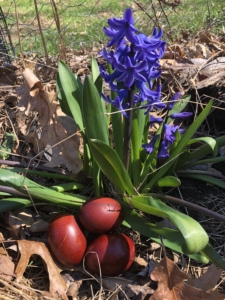The Traveler’s Dream: Monet’s Garden

The Traveler and the Cook
Our Cooking Instructor, Eva Szigeti, paints a beautiful mental picture of Monet’s Garden and, meditating on color as Monet did, provides a vibrant egg dying recipe that utilizes kitchen scraps.
There are travel destinations we will always remember, there are places we hope to revisit one day, and there are those we have only ever visited in our imagination. High up on my personal wish list of travel destinations is a remarkable French garden: Monet’s Garden in Giverny.
It is early spring, the part of the year when gardeners returns to their gardens. There is plenty to do, and the gardens already have gifts to offers: daffodils and hyacinths are the first to bring color and flower-beauty into my garden, sorrel is already offering its citrusy leaves, a few arugulas and collard greens have survived the winter, perennial herbs like oregano, lovage, chives, and tarragon can already be harvested, reseeded dill and cilantro are emerging out of the ground. There promises to be a good rhubarb harvest in few weeks. And yes, as I am trying to be grateful for what there is, I can’t stop wishing for a garden at its peak. It is spring, and spring is the season when a gardener is most likely to dream about all the potential hidden in their plot of land, but also to fantasize about extraordinary gardens. I am being taken to Monet’s Garden…
The garden in Giverny is special for multiple reasons. Monet’s Garden is unquestionably a work of art, but the garden is not only unusual because of its extraordinary beauty. A friend who has experienced this garden first-hand noted that its aesthetic qualities rival those of Monet’s paintings. This is a landscape that was created by an artist with the intention for it to be the subject of his art; the material for his study of colors and light. We see a double artistic intention here: the garden itself can be viewed as a piece of art, though it was created to be the subject of paintings. This piece of land was the artist’s muse; the flowerbeds are like models posing for the painter in the outdoor studio of a carefully orchestrated landscape. Looking at pictures of Monet’s garden, it is easy to see the origin of his paintings. Even those who haven’t seen the garden recall the image of wisterias covering Monet’s Japanese bridge, the water lilies, or the reflection of red azaleas on the surface of the water.
Being an artist (an impressionist painter, to be exact), Monet designed his garden mainly around color. His main interest was the exploration of colors and the study of color’s interaction with light. He embraced the element of water because of its reflective quality. He considered reflective qualities of petals and foliage in his garden design, and observed and painted flowers (colors) under different light circumstances. Monet’s favorite color harmonies were yellow-blue and blue-pink, and triadic combinations of red-silver-green and blue-pink-white. He used white flowers to create a magical look of glitter scattered on the landscape.
While his designs were elaborate and labor and space intensive, I am contemplating if it might be worthwhile to experiment with Monet’s color harmonies on a small scale in my own garden. Maybe. . .but for now, it is time to plant carrots.
While dreaming of visiting Monet’s garden someday, I am heading with my box of seeds to my not-so-picture-perfect (but beloved) garden. There is a lot to be done. . .trips get taken, paintings get finished, but gardens are ever changing landscapes of works in progress.
Dyeing Eggs with Onion Skins
Let’s cook up some color! Nature offers some great dyes, and humble onionskin is one of them. We use it every spring to dye eggs for Easter. The process is straightforward and comes with no mess. Just plan ahead and remember not to compost your onion skins.

If possible, use eggs with shells of different colors. White eggs will take up the color differently than brown eggs. The final color of brown eggs will vary too, depending on what shade of brown the shell is.
6 eggs
3-4 handfuls of yellow onion skins (yellow, red or combination)
1 tablespoon of vinegar
A few drops of cooking oil
Put the eggs and the onion skins into a pot. Add enough water to cover the eggs, add vinegar. Bring the water to boil and gently simmer for 10 minutes. Using a slotted spoon, take the eggs out of the liquid. Let them cool. Using a soft cloth and a few drops of cooking oil, polish the dyed eggs.




